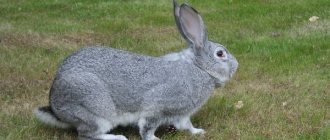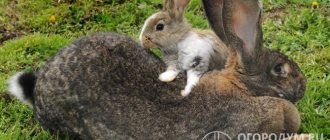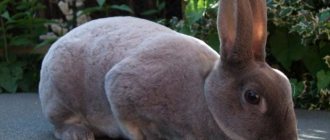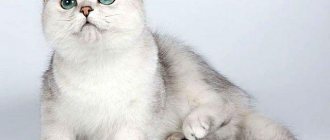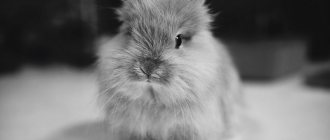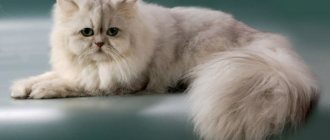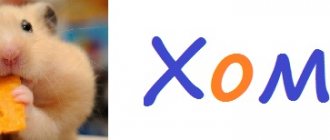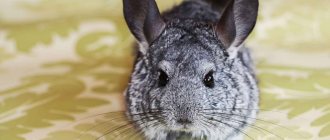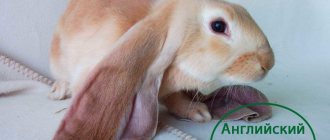According to the description, rabbits of the “Soviet Chinchilla” breed are among the most profitable for breeding. The main advantage is high-quality fur, widely used in the fashion industry. The meat of the animal is considered dietary: it contains very little fat, and besides this, it is very tasty. Another advantage of the breed is its unpretentiousness: the animals eat well, have strong immunity and good character. All this allows even novice farmers to breed chinchillas.
Origin story
Photo:
A breed of rabbit called Chinchilla was originally bred in France at the beginning of the last century. This name for the fur breed was chosen because the color of the rabbits is similar to the color of the chinchilla itself, a small gray rodent native to South America.
To develop the breed, French breeders crossed the Baveren blue, Russian ermine and wild rabbits. The chinchilla breed was first introduced at the Paris Exhibition in 1913, and over the next decade these rabbits quickly spread throughout Western Europe.
Subsequently, English breeders improved the breed by crossing it with a giant rabbit. As a result, the weight of the animals increased from 2.5 kg to 4 kg. Currently, European rabbit breeders raise both small intrabreed types and large ones.
In the second half of the 1920s, the Soviet Union also showed significant interest in the new European breed.
However, chinchillas were completely unadapted to our climatic conditions, and their small size (at that time the large type had not yet become widespread) also made the breed not entirely suitable for the needs of the Soviet economy.
An experimental batch of chinchillas was imported from the USA (according to other sources, directly from France), and Soviet breeders began improving the breed. Crossbreeding was carried out with various large breeds, and primarily with the white giant.
Other methods were also used, in particular classical selection under conditions of improved feeding. Gradually it was possible to increase the average weight of the rabbits to 4.5-5 kg, which was considered a sufficient result.
A new breed of rabbits, the Soviet chinchilla, was officially registered in 1963. Since then, rabbits of this breed have been bred very actively in our country, while the original breed (French chinchilla) has not become widespread in our country.
In practice, Russian rabbit breeders often use the terms “chinchilla” and “Soviet chinchilla” as synonyms, meaning specifically the Soviet breed.
Due to the popularity of the Soviet chinchilla in Russia and the lack of a significant number of ordinary chinchillas, later in the article we will also mean the Soviet chinchilla.
What are the characteristics of
Soviet chinchilla rabbits are very popular in our country. They are grown by both large breeders and small farmers. True, in private households they are often kept for decorative purposes.
The original color of the velvety and lush fur - bluish with a silver tint - gives the animals a wonderful decorative appearance. White patches are noticeable on the wide belly and around the large eyes. The breed standard is the heterogeneous color of the fur of Soviet chinchillas. It is these animals whose fur is extremely valuable; the skins of these animals are constantly in great demand. When the fur swells against growth, you can see how one color tone smoothly transitions into another: at the base the color of the fur is blue, which gradually changes from black to white, then to gray towards the tips. There is always a white spot on the back of the head behind the ears.
From their “parent” - the white giant - the animals received large body sizes and a fairly high body weight. The skeleton is strong, powerful, the body is large and well-built. The back is elongated, the head is medium in size with straight-set small ears. The chest is wide, of medium depth, hips are rounded.
Main defects
It happens that rabbits are born in a litter that have obvious defects. It should be remembered that such animals should be culled and separated, since they are not suitable for further reproduction.
Main defects:
- bald spots, uneven fur on the skin, red color in the color of the animals;
- the back is not straight, but with a hump;
- the croup hangs down;
- Ears are too large, hang down or “break”.
Description of the breed
American Chinchilla Rabbit
Characteristics:
- Rabbits have a rather massive build. The body is strong and slightly elongated (average length about 60 cm) with a massive sternum (circumference about 38 cm).
- Although individual individuals can weigh up to 7 kg, the average weight is about 5 kg.
- The head is medium sized with medium erect ears.
- The dominant color of the Soviet chinchilla is silver-blue. The lower edge of the tail, abdomen and the inside of the paws are painted in a much lighter color. The tips of the ears and tail are black.
- A feature of the breed is the zonal nature of the color with uneven transitions. At the same time, the fur itself is of very high quality: uniform and quite thick.
- Animals have a curved and elongated back.
- The ears are straight, erect, and medium in size.
- Hips are rounded.
- The paws are large, strong, fleshy.
- The eyes are usually cherry-brown, but blue can also be seen.
- The legs are strong and straight, well muscled.
- The character of the Soviet chinchilla is excellent; their behavior is no different from smaller rabbits. They are also kind, sympathetic and love affection. But due to their large size, keeping them at home is too problematic.
What to look for when purchasing
When buying a purebred animal, you need to pay attention to two points: documents and appearance. And both are equally important.
On the one hand, without properly executed papers, it is impossible to say with confidence that this is a valuable Soviet chinchilla, and not an ordinary gray rabbit (the animal’s bright iridescent fur does not appear immediately, the animal must shed at least once, moreover, If the breeder does not have sufficient experience, it will not be difficult for scammers to mislead him with sweet speeches).
On the other hand, as the hero of a Soviet joke said, they hit you not on the passport, but on the face, therefore, no matter what seals and coats of arms the tribal papers are decorated with, if their “owner” looks half-dead and unhappy, the documents are unlikely to save him from death, and you from inevitable losses.
Important! Beginning breeders should pay attention to adult animals, since young animals have less pronounced main external characteristics of the breed, which means they can become a victim of deception.
Another option is to buy from a well-trusted seller. When examining the animal, we pay attention to the following points:
- A healthy animal has clean and shiny eyes, a strong body, thick and fluffy fur;
- the rodent must behave actively, look well-fed and satisfied with life;
- the coat should have a characteristic silvery tint - lighter in the lower part and darker in the upper part of the body, a dark outline on the ears and tail, white areas under the eyes, the fur is thick and very pleasant to the touch.
Video
Price
Carefully inspect the suitable candidate before purchasing. The animal must not have visible defects in the build or on the surface of the skin. A healthy rabbit's eyes are clear and clean, and its fur is shiny and fluffy.
The characteristic white down is easily crushed under your hand. The animal is active and has a good appetite. Only such signs will indicate the health and suitability of rabbits for breeding. Determining the sex of rabbits is also easy.
The cost of chinchilla breeds is relatively high and will depend on the breed. It is quite problematic to purchase a classic chinchilla from us.
The more common Soviet chinchilla can be bought from $4 per animal. Giant chinchillas are also in high demand, but here prices will vary from $4.5 to $7. A breeding adult animal will be much more expensive - from $5.5.
How to choose the right rabbit?
- Buy rabbits only from trusted, reputable rabbit breeders.
- When purchasing, ask for documents confirming purebred.
- Watch the animals: they should be active.
- It is important that the eyes do not water, the ears stand up, and the coat and body have no flaws.
Reviews
According to customer reviews, this breed is classified by most rabbit breeders as universal, although it was originally conceived as a meat-skin breed with an emphasis on the skin direction.
It is, of course, inferior in productivity to pure meat breeds, but with proper adherence to growing technology, chinchilla can provide higher profitability precisely due to the balance of skin and meat products.
As follows from the description of Soviet chinchilla rabbits, their strengths are as follows:
- High quality fur. The hair density of the Soviet chinchilla is 50% higher than that of other breeds. Plus here we need to add the noble gray color, so reminiscent of the very rodent after which the breed is named. All this allows the skins to be successfully sold to processors at a price significantly higher than the cost of skins from other breeds.
- Heavy weight. Due to the fact that chinchilla rabbits grow up to 5 kg, when slaughtered they produce a very large carcass with a lot of meat.
- Undemanding to living conditions. Soviet breeders fully succeeded in creating a very unassuming animal. A chinchilla can be successfully kept in any adequate conditions, eating simple, easily accessible food.
The weaknesses of the chinchilla breed are:
- Small offspring. With an average number of rabbits in one litter of 7-8 pieces (and sometimes only 5-6), the Soviet chinchilla is noticeably inferior in this indicator to many other breeds. Because of this, in order to obtain a large number of young animals, farmers have to maintain a fairly large number of queens.
- Low lethal yield. The meat yield per carcass of a chinchilla is on average 4-5% lower than that of other breeds. At first glance, this is a rather significant figure, but we should not forget that this parameter is more than compensated for by higher quality and more expensive fur.
Subspecies
These animals were bred in France, trying to replicate the fur structure of the South American small rodent. Subsequently, the chinchilla rabbit ended up on the territory of the former USSR. Here they tried to increase the size of the animal and the meat yield. As a result of the integrated approach of scientists (NIIPZK) and workers of the Saratov state farm "Anisovsky", the Soviet chinchilla breed was developed (registered in 1963).
Unpretentiousness is the main feature that everyone likes. Even for rabbit breeders with little experience, losses are minimal. Animals grow and reproduce quickly. With the traditional method of rearing, amateur rabbit farms produce up to 80 kg of carcass meat per year.
Proposed by I.N. Mikhailov, the technology of accelerated rabbit breeding makes it possible to obtain more than 120 kg of meat in carcasses, as well as at least 30 especially large premium skins per year. Today, this popular technology attracts many people.
Work to increase mass is being carried out all over the world. In the late eighties of the last century, giant rabbits were bred in Great Britain. They are represented by the British Chinchilla breed. It is distinguished by its solid mass (individuals grow up to 16...18 kg).
A feature of the new giant breeds is their low growth rate. These rabbits appeared on the territory of the Russian Federation in the early nineties
They attracted the attention of amateur rabbit breeders
By crossing animals with local representatives, primarily with the Soviet chinchilla, they obtained a new subspecies. They call him Russian chinchilla. Rabbits do not have gigantic sizes, they are more modest (10...12 kg). Their main difference is the growth rate. By six months, the young animals gain live weight up to 8 kg. At the age of 7-8 months the skin matures. Slaughter during this period makes it possible to obtain fur pelts of enormous size and excellent quality.
Carrying out crossbreeding work with other breeds, we got an unexpected result: they created a subspecies of chinchillas whose fur resembles black-and-fire rabbits. Work on the subspecies continues. They try to breed animals where the breed characteristics will be stably preserved in all subsequent generations. Attracts the original black fur with transitions like the base breed. The weight has also increased, which allows us to hope for good productivity in this indicator as well.
Productivity
Initially, the breed was conceived as a skin breed, and meat characteristics came as an additional bonus. However, in practice, breeding chinchilla rabbits pursues both goals - obtaining both meat and skins.
The quality of the fur of the Soviet chinchilla is on average one and a half to two times better than that of ordinary rabbits. For this reason, chinchilla skins are readily purchased by enterprises specializing in the production of fur products.
Moreover, often the fur does not even have to be tinted, as is the case with the fur of other breeds of rabbits. The natural color looks solid enough to be used in its original form.
As for meat indicators, the slaughter yield at 120 days of age in rabbits of this breed averages 56-58%.
This is noticeably lower than that of ordinary rabbits (60-62%), but do not forget that meat in this case is not the main product. However, some individuals provide even 63%.
Soviet chinchillas show fairly rapid growth rates in the first two months of life, but then slow down significantly.
Having a birth weight of about 75 grams, on the 60th day they reach an average of 1.8 kg, after another month - 2.5-2.8 kg, on the 120th day - 3.5-3.7 kg. Fully mature rabbits weigh on average about 5 kg. Feed conversion per 1 kg of live weight gain in young animals is 3-4 kg.
The fertility of females is not very high: on average there are about 7-8 rabbits in one litter. Thanks to this moderate indicator, female rabbits can easily feed their offspring.
Economic characteristics
Soviet chinchillas are bred both in small private farms and in large breeders. Rabbits quickly pay for themselves, since the demand for blue fur and dietary meat is always stable.
Economic characteristics of the breed:
- Slaughter age is 3-4 months.
- The cost of sexually mature individuals is 3-4 months, about 1000 rubles.
- The average cost of fur is 3,500 rubles.
- Lean meat - suitable for children and dieters. The meat has a minimal amount of bones and tendons. The fat layer contains few calories.
Chinchilla skins are readily purchased by felt and fur factories.
Breeding
The Soviet chinchilla has average fertility rates. Females become pregnant several times a year. Sexual maturity occurs at 3.5 months, but to be sure of the offspring, a female 5-6 months old is taken for mating. During the year, the female can participate in mating up to 6 times.
The female estruses every 5-7 days, in winter - once every 8-9 days. During the hunt, the female rabbit behaves restlessly. For mating, the female is placed in a cage with the male, but not vice versa.
During mating, the feeder and drinking bowl are removed. To check whether the female is covered, 5-6 days after mating she is again placed in the cage with the male. If she behaves aggressively, it means that fertilization has occurred successfully.
Content
Soviet breeders who were creating a domestic version of the chinchilla breed had the goal of not only increasing the weight of animals, but also adapting them to more difficult weather and climatic conditions, and making breeding Soviet chinchilla rabbits less complicated and costly.
As a result, the rabbits turned out to be very unpretentious in matters of feeding and maintenance.
They do not require any special conditions.
The main thing is to follow the basic rules of caring for domestic rabbits:
- keep cages clean, regularly clean and change bedding;
- provide animals with simple but balanced feed;
- maintain a regular feeding schedule;
- provide rabbits with constant access to drinking water, which needs to be slightly heated in winter;
- in summer, shade the cells from direct sunlight;
- in winter, protect animals from wind and drafts.
Since chinchilla rabbits naturally have very thick and warm fur, they can be kept in outdoor cages in winter. However, to maintain their productivity in such conditions, it is necessary to increase the calorie content of their diet by 15-20%.
For commercial breeding, chinchillas can be kept in industrial sheds or mechanized rabbitries. In a private yard, you can use any cages, including homemade ones.
The only maintenance method that is not recommended is pits.
Since the main value of these rabbits is their fur, it is important that it always remains clean, which is almost impossible to achieve when kept in pits.
In the enclosures
This option is suitable for areas with a mild climate and warm winters. When kept in an enclosure, rabbits can be provided with grazing. The problem with this method of keeping is the behavior of rabbits.
They are burrowing animals and can make a dig.
Features of the organization of enclosure maintenance:
- You need a free plot of land covered with grass.
- An awning is pulled over the top to protect from the sun.
- Slate is dug in around the entire perimeter of the enclosure to protect against digging, or the floor is covered with a metal mesh.
- Install side feeders. You can’t pour food on the floor, only into feeders, so that the animals don’t get an intestinal infection.
When kept in an enclosure, you don’t have to clean the cages every day. Disadvantage: uncontrolled reproduction and inbreeding.
In cells
Caging is the best option for breeding rabbits with valuable fur.
Advantages of the method:
- Possibility of individual feeding and rational use of feed.
- Prevention of consanguinity and birth control.
- Possibility of monitoring animals and timely detection of sick animals.
In warm climates, rabbits can be kept in cages all winter. Where winters are harsh, the animals are transferred to special insulated rabbit hutches.
Features of cell arrangement:
- The cages are placed so that they are not exposed to direct sunlight and cold winds do not blow.
- The length of the cages is approximately 3.5 m. Large animals need space. If rabbits don't move enough, their joints will hurt.
- Materials for cages are wood and mesh. Wooden cages have slatted floors so that droppings fall down.
- Feeders and drinking bowls are attached to the edges of the cages. Learn about making drinking bowls with your own hands from this article.
- A queen cell is made in the breeding cage. In this house, the mother rabbit sets up a nest for her young rabbits. Queen cells can be removable or stationary.
- Cages can be installed in barns - during the cold season. They are also arranged in 2-3 tiers - under a canopy.
Care
Soviet chinchilla rabbits were bred to improve the initial qualities of their small American relatives. First of all, we paid attention to the following characteristics:
- Weight gain
- Adaptation of animals to cold weather
- Improving the quality of fur.
After all, the Russian winter is harsh; not all breeds can withstand frost and sudden temperature changes. Therefore, chinchillas are unpretentious animals adapted to our climate.
Rabbits are raised both on small farms and on large farms. The housing system is cellular. In summer, it is advisable to keep animals outdoors, this will improve their immunity and accelerate growth. Chinchilla rabbits do not tolerate heat well, so the cages are placed in the shade and the roof is covered with straw. On particularly hot days, water the cage with water. In winter, rabbits are moved indoors. There should be no drafts, the temperature should be between 11-14 degrees.
The cages are installed on poles about 70-80 centimeters high. The floor is made solid or with a metal mesh. The size of the mesh cells is 16×18 mm. The roof is made of wood, always with a canopy. Chinchilla rabbits are kept in groups of 2-3 in one cage. Females with rabbits are placed in separate cages, just like breeding males. The cells are cleaned 1-2 times a week, and thoroughly disinfected every 2-3 months.
Feeding
The diet of the Soviet chinchilla does not include any exotic food.
Everything is simple and quite variable:
- in summer fresh grass (both meadow and seeded);
- grain feed, including compound feed;
- fresh vegetables (boiled potatoes only);
- hay not only in winter, but also as a top dressing in summer;
- meat and bone or fish meal;
- if possible, reverse and whey;
- vitamin and mineral supplements.
When kept at home, it is quite acceptable to include in the diet plant food waste (but not spoiled), weeds and plant residues (for example, tops) from the garden and garden.
Rabbits will be very grateful if branches of bushes and trees periodically appear in their feeder.
Features of feeding rabbits:
- When kept at home, the basis of the feed is green food and hay. You should not give branches of stone fruit trees - they contain harmful substances.
- The animals are fed carrots, turnips, raw potato peelings (in small quantities), beets (learned gradually), kale, pumpkin, zucchini, Jerusalem artichoke, cucumbers, and lettuce.
- In order for rabbits to grow well, they are given grain mixtures that include corn, oats and barley. Or they give you mixed feed - in addition to grain, it contains meal, fish or bone meal, and various additives.
- Rabbits can be fed vetch, alfalfa, sweet clover, red clover, and fireweed. The grass is first dried, otherwise digestive problems may occur. Oatmeal, corn and rye sprouts are useful for animals.
- It is allowed to feed wild meadow grasses - nettle, plantain, reeds, yarrow, dandelion, oregano and other edible species.
- Among wild herbs there are many poisonous ones. Do not feed rabbits hemlock, foxglove, celandine, or dog parsley.
What to feed
Food for rabbits must be properly balanced and include the following mandatory components:
- fresh herbs, peels of vegetables and fruits. From such food, the rodent’s body receives the fiber necessary for the normal functioning of the digestive system and intestines;
- vegetables and silage (succulent feed), especially in winter, when the amount of fresh greens is limited;
- roughage, which is also a source of fiber and, in addition, vitamins, minerals and protein. This is primarily hay, but also branches, straw and grass meal;
- concentrated feed. In addition to feed, this group also includes various cereals and legumes, for example, corn, oats, barley, rye, wheat, peeled peas, lentils, soybeans, beans, oilseed waste, meat and bone meal and fish meal.
In addition to these components, vitamins and minerals must be added to the diet of Soviet chinchillas (in particular, for this purpose the animals are given chalk and table salt).
Important! The diet of rabbits should be taken very seriously, since their digestive system categorically does not digest a huge amount of seemingly absolutely harmless plants and products (for example, iceberg lettuce, red cabbage, honey, sugar, tomatoes, mushrooms, etc.). The list of prohibited products should be studied and taken into account so as not to lose the entire livestock overnight. In addition, the rabbits' food should always be clean and fresh, so you should not give it too much so that the animals do not scatter it on the bedding.
In addition, rabbit food should always be clean and fresh, so you should not give it too much so that the animals do not scatter it on the bedding.
Diseases and their treatment
The best way to protect rabbits from diseases is to follow the rules of keeping and timely vaccination. There are diseases that develop so quickly that they lead to the death of rabbits within a day or two.
Rabbits are vaccinated 2 times:
- first vaccination – at the age of 1.5 months;
- the second vaccination – 2-3 months after the first.
The most common diseases of rabbits:
- Coccidiosis. Prevention with anthelmintic drugs is necessary. The disease can lead to the death of animals if not treated promptly. The liver and intestines are affected. The causative agents are single-celled parasites - coccidia.
- Myxomatosis. Tumors appear on the animals' bodies. This disease is viral and is transmitted by blood-sucking insects. Infection also occurs through objects. There is no specific treatment. Sick individuals are eliminated, and the premises are disinfected, imposing a long quarantine. There is only one prevention – vaccination.
- Pasteurellosis. Transmitted by wild birds and rodents. Symptoms are fever, lethargy, loss of appetite. Hemorrhages appear in the internal organs. There is no effective treatment.
Giant chinchilla
The giant chinchilla is in many ways similar to the Soviet chinchilla, but giant rabbits are even larger and more powerful. This breed was developed by crossing the silver subspecies with the Flanders.
They have an elongated, rounded body and straight ears. Color – light blue. There are snow-white splashes around the eyes. The lower part of the body is snow-white.
The subspecies is beneficial for breeding. The weight of individuals is 6-7 kg. Maintenance requires spacious cages, plenty of water and food.
Advantages
The special advantages of the fur of these rabbits include high wear resistance. If a fur coat made from a simple rabbit will serve you for up to 3 years, then a warm fur coat made from a royal rabbit will delight you for up to 5 years. Due to the high quality of these products, their cost reaches almost the level of the cost of mink coats.
Rex rabbits were bred by German farmers a hundred years ago. For more than fifty years they protected the monopoly on the production of luxurious products from this animal. However, one of the Soviet geneticists was still able to breed a couple of such breeds. By crossing with local purebred rabbits, almost purebred rexes were bred over several generations.
Crossing the Soviet chinchilla with other species
To obtain good livestock for fattening, the Soviet chinchilla is crossed with other breeds. A good result is obtained by crossing female Soviet chinchillas with a male White Giant or New Zealand White.
Orylag - chinchilla hybrid
Orylag is a rabbit that was bred by French breeders from the best representatives of the Rex rabbits. It belongs to the hare family, chinchilla order, and is the youngest species created in the last century.
The French government allocated huge amounts of money for these developments. The scientists' task was to breed a mixture of an animal whose fur would be as dense and silky as that of a chinchilla, but the size of the skin would be much larger.
It took 15 years of painstaking work to obtain the necessary results, but the expectations and costs were justified. The final material turned out to be warm, durable, and easy to use.
Today there are three shades of Orylag:
- “Chinchilla” – light gray in color.
- “Ash Gray” is an ashy shade.
- "Beaver" - brown.
The demand for outerwear made from orylag is growing steadily. But despite this, rabbits are still raised in only 25 farms. The process is strictly controlled by the French government, since Orilag is a national treasure and the pride of the French.
